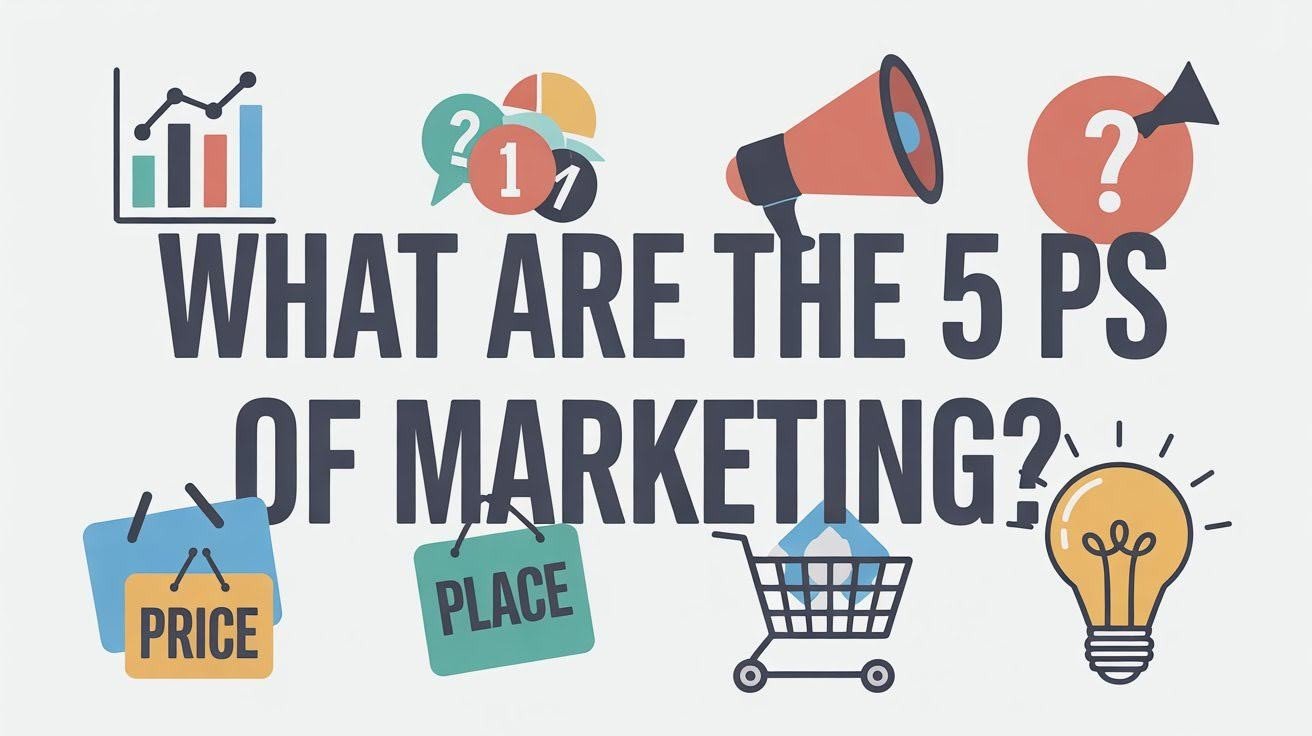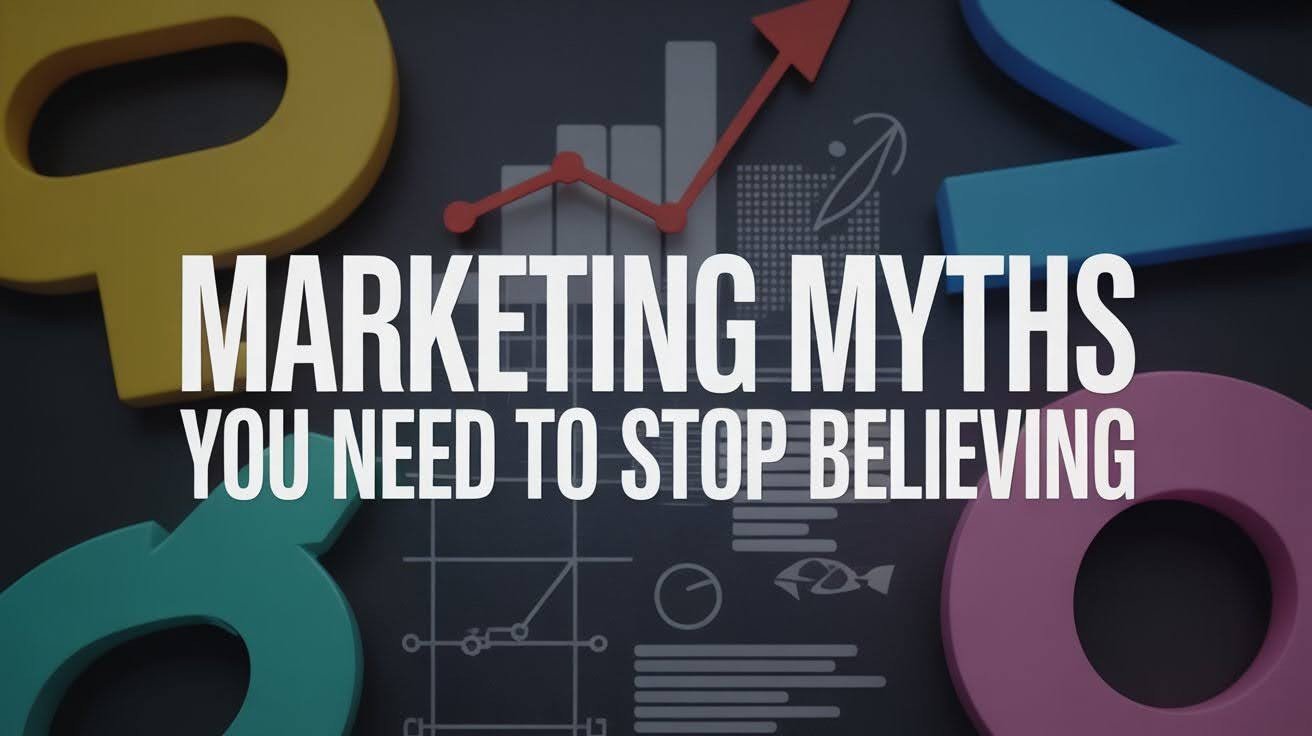When did you last buy a thing you liked? What did you like about it? The answer is probably the 5 Ps of Marketing, even if you had no idea.
The five elements of Product, Price, Promotion, Place and People are always involved in every purchase you make and every brand you trust.
When the original 4 Ps were developed in the 1960s, they included a P for People, because marketers recognized that you, the customer, are key.
When businesses get these five things right, it creates a magical interplay among the decisions that we make every day.
Understanding the 5 Ps of Marketing

The 5 Ps give you a simple framework to plan your marketing. They help you cover all the bases without missing critical details.
When you use this model, your campaigns stay focused. You make better decisions about where to spend your budget. Your team works toward the same goals.
This framework asks the right questions. Are you targeting the right audience? Does your pricing make sense? Is your message clear? The 5 Ps guide you to the answers.
Origin and Evolution of the 5 Ps
In 1960, E. Jerome McCarthy created the 4 Ps: Product, Price, Place, and Promotion. This model became the foundation of modern marketing.
But something was missing. Markets changed. Customer expectations grew more complex.
That’s when marketers added the fifth P: People. This addition changed everything.
People include your customers and their behaviors. It covers your staff and how they represent your brand. It even considers social factors that influence buying decisions.
Today, the 5 Ps offer a complete view of marketing. They remind you that business is about human connections, not just transactions.
Breakdown of Each P in Marketing
Each P plays a specific role in your marketing strategy. Together, they create a complete plan that connects your business with customers. Let’s look at what each one means for you.
1. Product – What You Offer

Your product is what you sell. It can be physical goods, digital items, or services.
Focus on what makes yours different. Think about features, quality, and packaging. Your unique selling points set you apart from competitors.
Slack added video calls to their messaging app. Users wanted all their tools in one place. This change made the product more useful.
Listen to customer feedback. Products that respond to real needs win in the market.
2. Price – How Much You Charge

Pricing shapes how customers view your brand. It’s more than just covering your costs.
You can choose premium pricing for luxury positioning. Penetration pricing helps you break into new markets. Value-based pricing matches customer expectations. Dynamic pricing adjusts to demand.
Consider your costs, competitor rates, and what customers can pay. Use psychological pricing like tiered packages to help buyers choose.
SaaS companies offer free plans, basic options, and enterprise packages. This gives customers choices that fit their needs and budgets.
3. Place – Where Customers Find You

Place is how you get products to customers. It covers both physical and digital channels.
Sell through stores, websites, or marketplaces. Use pop-up shops for special events. Build digital funnels for B2B sales.
Place also means ad positioning. Show up where your customers already look. Target them when they’re ready to buy.
4. Promotion – How You Communicate

Promotion is how you spread the word. It includes every tactic that raises awareness and drives sales.
Use social media, SEO, influencer partnerships, email campaigns, PR, and paid ads. Mix multiple channels for better results.
Smartphone launches use YouTube ads, billboards, social posts, and store displays together. This repetition makes the message memorable.
Choose channels based on where your audience spends time.
5. People – Customers and Employees

People drive your business. This includes your customers and your team.
Understand customer behaviors, needs, and preferences. Know what problems they face and how they like to shop.
Your employees represent your brand every day. Sales teams, customer service reps, and all staff shape how people see you.
An eco-friendly fashion brand hires sustainability-focused staff. They attract like-minded customers. This shared belief makes the brand genuine and powerful.
Examples of 5 Ps in Real-World Scenarios
Seeing the 5 Ps in action makes them easier to understand. Let’s look at how different businesses apply this framework to reach their goals.
B2B Example: Marketing Analytics Software
- Product: A platform that tracks campaign performance and provides data insights for marketing teams.
- Price: Competitive rates with similar tools. Offers a free trial so companies can test before committing.
- Place: Sold through digital channels. No physical stores needed. Customers download and access everything online.
- Promotion: Publishes helpful blog posts about marketing metrics. Runs targeted campaigns on LinkedIn and industry websites.
- People: Product experts guide new users through onboarding. They make sure teams know how to use every feature effectively.
B2C Example: Sustainable Clothing Line
- Product: Eco-friendly fashion made from organic and recycled materials. Stylish designs that don’t harm the planet.
- Price: Mid-to-high range. The cost reflects quality materials and ethical production methods. Customers pay more for sustainability.
- Place: Sells mainly through an online store. Opens pop-up shops in major cities to let customers see and feel the products.
- Promotion: Runs social media ads showing the brand story. Partners with influencers who care about environmental issues.
- People: The Customer service team shares the same values as buyers. They connect with customers who want to make responsible choices.
Why the 5 Ps Are Important for Your Marketing Strategy
The 5 Ps help you plan complete campaigns without missing key details. They give you a clear framework to organize your marketing efforts and make smart decisions.
This approach keeps your entire team aligned. Everyone uses the same language and works toward the same goals. Your brand message stays consistent across all channels.
You can measure performance using the 5 Ps as your guide. When something isn’t working, the framework shows you where to fix it. Maybe your pricing needs adjustment. Or your promotion needs a new approach.
The 5 Ps work for any marketing channel. They apply to traditional ads, digital campaigns, social media, and email. This flexibility makes them useful no matter how you reach customers.
Tips to Effectively Use the 5 Ps of Marketing
- Start with customer research. Talk to your audience before defining each P. Ask what they need, want, and struggle with. This data guides every decision you make.
- Match pricing and promotion to your audience. Make sure prices fit their budgets. Use language and channels that speak to them directly.
- Test different channels. Don’t assume where customers will find you. Try various options for selling and promoting. Track results and focus on what works best.
- Train your team. Make sure everyone understands your brand values. Align staff across departments to deliver consistent customer experiences.
- Review and update regularly. Markets shift fast. Revisit your 5 Ps every few months. Adjust products, prices, and tactics as trends change.
Conclusion
The 5 Ps of marketing form the basis of any marketing strategy. The 5 Ps of marketing (Product, Price, Place, Promotion and People) can form an effective marketing campaign.
Whether you’re just starting, or you’re mid-career, the system will organize you, show you what’s working, and what’s not working. You can see across your whole career what’s happening.
Think about your marketing effort in the context of these 4Ps for a moment and, being honest, where can you improve?
Start small. Pick one P to improve this month. Then, use the results to guide your next steps, and your marketing will be clearer, stronger!
Frequently Asked Questions
What are the 5 Ps of Marketing?
The 5 Ps are Product, Price, Place, Promotion, and People. They form a complete framework that helps businesses plan and execute effective marketing strategies.
Who created the 5 Ps of Marketing?
Jerome McCarthy introduced the original 4 Ps in 1960. Marketers later added People as the fifth P to include customers, employees, and social factors in the framework.
Why is People considered important in the 5 Ps?
People recognize that customers and employees drive business success. This element focuses on understanding customer needs and ensuring your team delivers consistent brand experiences.
How often should I review my 5 Ps strategy?
Review your 5 Ps every few months or when market conditions change. Regular updates help you stay competitive and respond to shifting customer preferences.
Can the 5 Ps work for both small and large businesses?
Yes, the 5 Ps apply to any business size or industry. Small startups and large corporations both use this framework to organize their marketing efforts and make better decisions.








